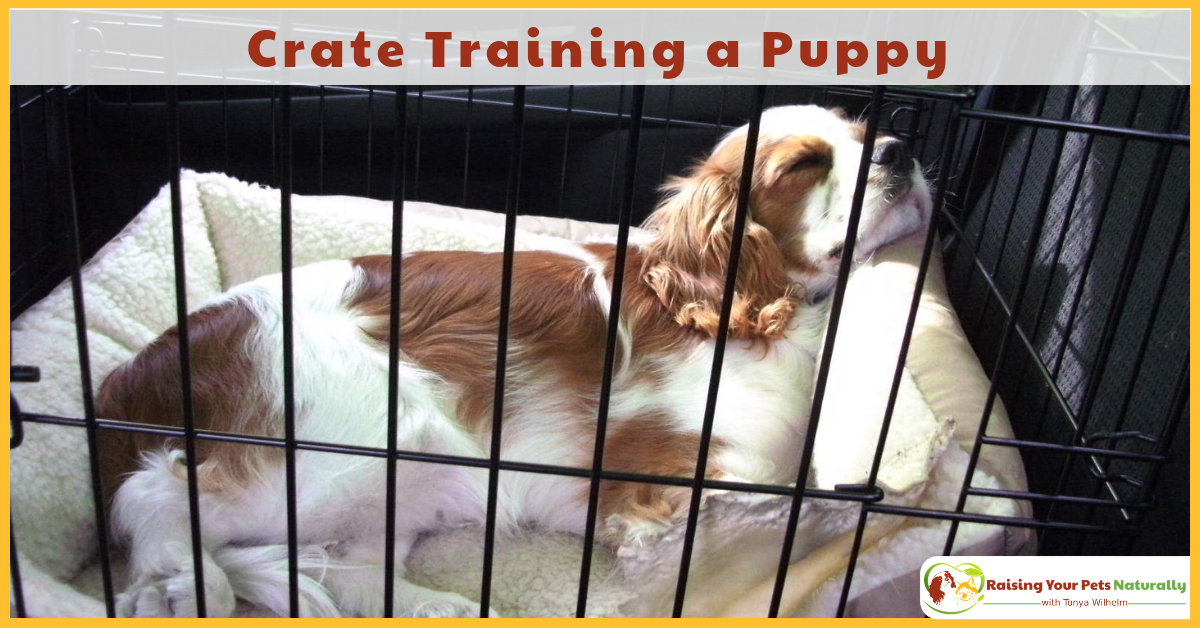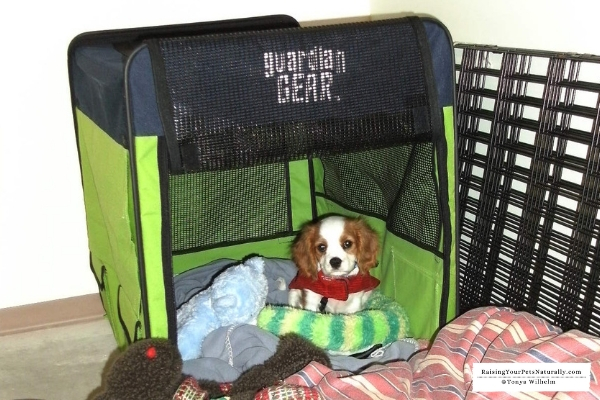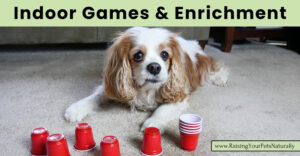Google Adsense—>


Excerpt from Proactive Puppy Care: Preventing Puppy Problems
Crate Training is a great tool in your puppy management plan. It can also be a wonderful management tool when there is too much household activity to manage your puppy effectively with one of the other management options. Another bonus in crate training is if your puppy ever needs to stay in your veterinarian’s office or goes to the dog groomer or boarding facility, he will be comfortable being confined to a crate. Taught correctly, this space can be a very comforting place for your puppy to sleep in. You may even find that your puppy seeks out his crate when he is tired, or needs a getaway. Do allow your dog the privacy he is seeking when he is in his crate.
Watch the video. Don’t forget to subscribe to my Youtube channel.
Dog crate size is the first thing to consider when choosing a crate for your particular puppy. Depending on the breed of puppy you have, you may need to purchase a smaller crate than the size he will ultimately be using. Your puppy’s crate should be large enough that he can stand up, turn around and stretch his legs out. Do not purchase a crate that makes your puppy hold his paws in an uncomfortable position. Remember, you want your puppy to enjoy his space and be comfortable inside his crate. On the flip side, too large a crate might encourage your puppy to eliminate in one corner and sleep in the other. Some crate styles such as the wire crate often come with a divider so you can partition the crate smaller then allow more space and eventually remove it as your puppy grows.
Puppy crate style is the second decision in your purchasing choice. Dog crates come in all kinds of styles and choices. You can purchase wire crates, plastic crates, wood crates, or heavy-duty mesh fabric. All the styles have their pros and cons. One thing to consider is that your puppy is still in the chewing stage so a mesh crate might not be the best solution quite yet, and depending on the wood style, this too might be risky. Plastic dog crates have less opportunity for ventilation and do not fold up or store very well. Wire crates are not the best to look at and dogs have been known to push the crate in such a way that the wire sides unclip and collapse. Use zip ties to secure the ends if this is a concern. Personally, I have multiple wire crates and a mesh crate that I take with me to dog events that my dog can use at our display table if he wants to retreat from the crowd.
Willow learning that the crate is good. Don’t forget to subscribe to our second YouTube channel for more videos.

Dog crate location is the next decision. I personally feel that having your puppy’s crate in your bedroom is the ideal location, and offers several benefits to your puppy. The first benefit is that by allowing your puppy to be in your bedroom at night, you are increasing the ever-important bond with your puppy. Second, you will be able to hear your puppy at night if he needs to go out for a potty break during potty training or if he develops diarrhea. Third, if your puppy ever wakes up in distress from a loud noise such as a thunderstorm you are there to address the situation immediately.
If you choose another location other than your bedroom for your puppy’s crate, you will want to think about that particular environment. Remember that your puppy’s crate is supposed to be a pleasant and peaceful location. So do not place your puppy’s crate in a dingy spot or a noisy spot. Think about what happens during the day and how that will affect your puppy. Is the area noisy? Is there enough light, natural or artificial, to be comforting? Is there too much light that might be glaring and uncomfortable? All that said, you can have more than one crate in your house. Maybe you have a crate in your bedroom and a second crate in the main part of the house for easy access during quick crating times while you are home.
What to put inside the crate depends on your puppy’s chewing habits. Because puppies tend to do a lot of chewing and it can be dangerous and risky to leave bedding inside your puppy’s crate for your puppy to chew and swallow, I suggest introducing bedding gradually. The same would apply to leaving a toy or chew toy with your puppy. You will want to ensure first that your puppy can safely interact with his toys before leaving him unattended with one. Ensure your puppy always has access to fresh water.
Setting the right mood can increase your chances that your puppy will like his crating experience. This topic goes back to your crate location choice. Again, look for a place that is not noisy. I never recommend placing a puppy crate next to a window unless you pull the blinds or shades. The outside world is full of activities such as children playing and small animals moving about. If your puppy can view this from the crate it can cause anxiety or even agitation so to promote healthy sleeping habits make sure the view from the crate is limited.
Warmth is important to encourage your puppy to sleep. Make sure the room your puppy is sleeping in is comfortable and not chilly. Once you are confident that your puppy will not chew his bedding, a nice plush dog bed and blankets are perfect for inside your puppy’s crate.
Lighting is another piece of the mood puzzle. Darkness is wonderful when you are in the room with your puppy during crating. But the times when your puppy is crated and you are not sleeping in the same room with him, keep the room dim, but not pitch black.
Music is one of my favorite pieces of the crating process. Various research studies such as Dr. Deborah Wells’s The Influence of Auditory Stimulation on the Behaviour of Dogs Housed in a Rescue Shelter have shown that classical music helps to soothe dogs. Dr. Susan Wagner took it further with another study, BioAcoustic Research and Development Canine Research, and determined the best sequences and notes to use for optimal results for a dog to relax, then created the Through A Dog’s Ear CD. I highly recommend playing this CD during any crating times and placing the track on repeat. After hearing the CD a few times, your dog will become conditioned to relax and calm when they hear it playing.
Our calming dog music playlist.
A Word Of Caution: Please be thoughtful when using your puppy’s crate. Dogs left alone too long can suffer from a lack of social contact, physical exercise, and mental exercise. Common sense tells us that crating a puppy longer than he comfortably can “hold it” is too long. A good rule of thumb is that your puppy should not spend any longer in hours than he is months old. So if your puppy is three months old, he should not be in his crate longer than three hours at a time. Dogs or puppies that must remain in their crates longer than six hours should have someone come over in-between to have a potty break and social interaction.
More on teaching your dog to use the crate.
Have you crate trained your puppy? Tell me in the comments.
Are you looking for even more ways to stay up to date with Raising Your Pets Naturally? Sign up for the newsletter for more tips and promotions. Don’t forget to be social and Like, Follow and Subscribe.
Facebook Twitter Pinterest Instagram YouTube
 |
Dog training tracker & log book |

Google Adsense—>





